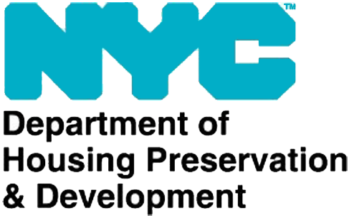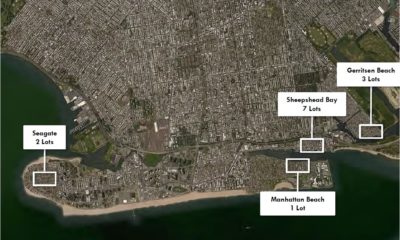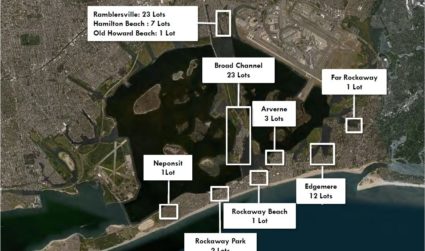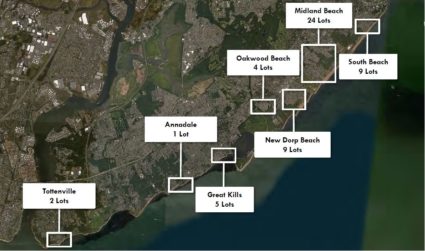
Image Credit: NYC HPD
The City uses ingenuity to make use of City owned spaces in flood plain. On September 25, 2019 City Planning unanimously approved an application to facilitate the construction of resilient housing and create open spaces on 141 city-owned properties, purchased in the aftermath of Hurricane Sandy. The properties involved sustained a level of storm and flood damage equal to at least half their respective value.
The high level of damage made the original owner eligible to sell their property to the City through the “Build It Back Recovery Program.” This application, brought by the Department of Housing Preservation and Development, will permit the City to convert the 141 purchased sites into either open spaces or resilient housing. Of the sites, 66 will be dedicated to open space and 75 will be dedicated to resilient housing. There are 13 Brooklyn sites, 74 Queens sites and 54 Staten Island sites.
At a public hearing on September 11, 2019, an application team led by the Department of Housing Preservation and Development gave an overview of the Build It Back Program, then discussed how each site was determined to be open space or resilient housing. The applicants stated that the assessment’s key consideration is a property’s sustainability. Following a sustainability analysis, the Department of Housing Preservation and Development will decide whether converting the property into open space or permitting the property to be redeveloped as sustainable housing is the appropriate measure.
The application team was prepared to give detailed analysis of all 141 sites had the Commission needed it.

Proposed Brooklyn Sites Image Credit: City Planning
Open Spaces
The team made clear that all open spaces will be required to be maintained as open spaces in perpetuity. No structures other than restrooms, public open spaces or flood control structures will be permitted. Compliance with these conditions will be enforced through deed restrictions and managed by city agencies. The open space lots intended for city ownership will be managed by Parks and the Department of Environmental Protection. Disposition of open space to private parties will be maintained through deed restriction.
Parks will acquire 25 lots, 19 of which will create new park areas in Ramblersville Marsh and Edgemere. The other six lots will be incorporated into Bayswater Park, Brant Point Wildlife Sanctuary, Crescent Beach Park, Blue Heron Park and the Tottenville Shoreline Protection Project. The Department of Environmental Protection will acquire five lots in Staten Island and incorporate them into the Staten Island Bluebelt. Administrative Services will acquire 23 lots and explore a lease model for the neighboring property owners.
The applicant team stated that Broad Channel will serve as a pilot program for private ownership of open space lots. Private ownership of open space lots will give next-door neighbors the opportunity to acquire and maintain the property as open space. According to the applicants, these open spaces will also be maintained in perpetuity, through deed restriction.
Resilient Housing
The resilient housing portion of the application requests permission to dispose of the properties through a deed restriction mandating the properties be redeveloped as flood-compliant residences. The alternative requests the disposal of the properties through private auction.
The deed restricting process is called the Request for Proposal Process. The owners will be required to maintain flood insurance in perpetuity. When properties identified in the Request for Proposal Process are conveyed, deed restriction will mandate the homes to be built to resilient home guidelines. The purpose of the resilient homes design guidelines is to encourage resilient and sustainable redevelopment of properties in the 100-year floodplain. The team stated that the guidelines should enhance seaside context through architectural features, maintain active streetscapes with porches and off-street parking, and encourage resilient and sustainable development with weather-resistant materials, elevated utilities and energy-efficient features. The applicants stated this method allows developers to bid on one or multiple clusters of land to create middle-income home ownership opportunities. The Department of Housing Preservation and Development’s Open Door Term Sheet project owners to be somewhere in the 80% to 130% percent area median income range. These redevelopment projects are expected to take approximately 18 to 24 months.

Proposed Queens Sites Image Credit: City Planning
In the alternative, the private auction pathway allows the city to sell a parcel of land to the highest bidder. Developers will purportedly create new housing in response to the market demand. The applicants point out that the design guidelines cannot be enforced after private auction. The private auction pathway is only intended for difficult to develop lots. Difficulties often include size of the lot, lack of street access and greater environmental concerns.
Commissioner Comments
At the special review session on September 9, 2019, Commission David J. Burney questioned the viability of the project. His questioned why the city would spend money to allow the redevelopment of sites in areas prone to flooding and storm damage. Burney again voiced this concern at the public hearing on September 11, 2019. This time he went further and questioned the long term waterfront policy and the decision to build housing in potentially uninhabitable areas. The application team claims to have worked closely with City Planning and the Resilient Neighborhood Planning Initiative, looked at other hazard mitigation plans, considered coastal erosion areas and the existing fabric of each specific neighborhood, in making these determinations. They believe the proposals are viable.
Commissioner Michelle de la Uz’s questioned the compatibility of the projected AMI levels and the need for housing in the proposed communities. She stated “it seems to me that this will be more appropriate for folks at 100 percent AMI or above. Given the limitation, I think it’s legitimate to ask how big a need there is for homeownership at that level, considering what the costs of flood insurance might be over time.”
The application team claims to have worked extensively with their underwriting team to anticipate flood insurance as it relates to homeownership. They believe the proposed AMI bands of 80% to 120% are proper. Nonetheless, they did not think that affordable housing homeownership given the high home owner’s association fees and flood insurance is responsible for lower income bands.

Proposed Staten Island Sites Image Credit: City Planning
Commissioner Raj Rampershad questioned the team on the practicality of sale or lease of open space to neighboring property owners. Essentially, he inquired what the owners would be permitted to construct on the lot or ways the owner might use the lot. The team responded that the owners will not be allowed lot mergers, will not be permitted to transfer the development rights nor will the owner be able to build structures (i.e. shed). The lots must remain generally open. When asked if a fence could be constructed, the team said it might be permitted in certain circumstances.
City Council will hear this application in the coming weeks.
By: Jason Rogovich (Jason Rogovich is the CityLaw Fellow and New York Law School Graduate, Class of 2019)


Is a list of the 141 city-owned properties available anywhere?